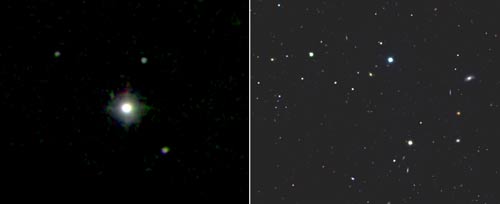Berkeleyan
 In the seconds after it first pointed at the March gamma-ray burst, the infrared telescope PAIRITEL was blinded by the brilliant explosion. As the burst began to fade (frame at left in sequence above), the telescope was able to track the light from the explosion for many hours. In the second photo, the burst has faded by a factor of more than 1 million. (Joshua Bloom/UC Berkeley) |
March 19 gamma-ray burst was first ever visible to the naked eye
Berkeley researchers burned the midnight oil to generate the first published report of the phenomenon
![]()
| 17 September 2008
A flash of light that blinded even small telescopes six months ago was the brightest astronomical explosion ever observed — visible to the naked eye despite originating halfway across the universe.
The gamma-ray burst, catalogued as GRB 080319B, was the result of a massive star’s explosion 7.5 billion years ago, which sent a pencil-beam of intense light on a direct collision course for Earth. It is the only known gamma-ray burst to have had a visible component bright enough to see without a telescope.
“This was the brightest optical and infrared event that mankind has ever recorded,” said Joshua Bloom, an assistant professor of astronomy at Berkeley and first author of an analysis of the event submitted to The Astrophysical Journal (ApJ) less than a week after the burst. (The paper was accepted last week.) “When more of these events are detected, we will open up the possibility of studying the infant universe with this new tool.”
The gamma-ray burst was first detected by NASA’s Swift satellite on March 19, after which many Earth- and space-based telescopes slewed into position to observe the rapidly fading light. Situated within the constellation Bootes, its flash eventually was pinpointed at a distance of about 7.5 billion light years.
Bloom’s group, using a robotic telescope in Arizona, began observing the intense infrared light just 54 seconds after the event began. The telescope, called the Peters Automated Infrared Imaging Telescope (PAIRITEL), was operating autonomously on a direct link from the Swift satellite. Bloom’s graduate students Daniel Perley and Adam Miller analyzed the data.
“This was the most powerful event ever seen in human existence,” enthused Bloom’s co-author, Berkeley astronomy professor Alex Filippenko. “A star that blew up and could be seen — barely — with the naked eye on a dark, moonless night, even though seven and a half billion light years away, is just astonishing.”
Filippenko calculated that if the supernova were located about 6,000 light years from Earth, the gamma-ray burst would have appeared as bright as the sun. Perley noted, too, that the burst at its peak was about 200 million times brighter than the entire galaxy in which it occurred.
Filippenko said that it is unlikely that anyone actually saw the flash, because it lasted only a few tens of seconds and appeared on a night with a bright moon. Astronomers know it reached a magnitude of 5.6, close to the limits of human vision, because a Polish observing program known as Pi of the Sky took several photos of the gamma-ray burst’s afterglow at the Las Campanas Observatory in Chile.
The Katzman Automatic Imaging Telescope (KAIT) at Lick Observatory also followed the fading afterglow of the burst, as did the Gemini South telescope in Chile. Bloom and his colleagues combined these observations with Swift data and Pi of the Sky images to complete their analysis.
The assimilation of new information about the event was particularly noteworthy. Less than six days after the event, Bloom’s group submitted a 42-page paper written during a planned mountain retreat. Miller, then new to the fast-paced gamma-ray-burst field said, “It was quite an introduction to research — my heart was racing for a week. I’m glad we decided to write instead of ski!”
Another paper, submitted weeks after Bloom’s paper and largely confirming those results, appears in the Sept. 11 issue of Nature and is authored by graduate student Judith Racusin of Pennsylvania State University and her colleagues.

